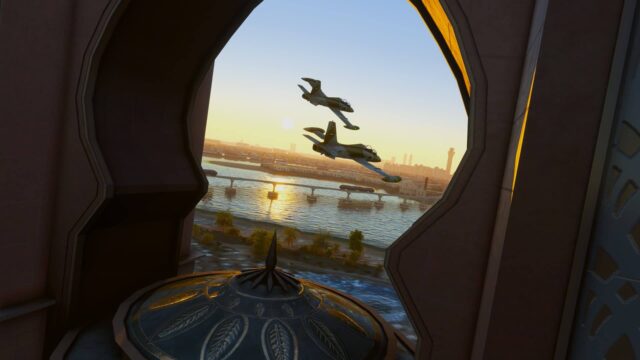 Peter Hayes in depth look at FS Addon’s latest product, The Super Cub X Collection by Simon Smeiman .
Peter Hayes in depth look at FS Addon’s latest product, The Super Cub X Collection by Simon Smeiman .
He starts off by giving us a quick summary: “I recently reviewed the A2A J-3 Cub and it should be noted that this Super Cub collection based on the PA-18, is a totally upgraded plane being developed from the PA-11, which was developed in turn from the J-3. You could call it the ultimate successor to the J-3.
For example, whereas the J3 was basic, the PA-18 models have an electrical system, flaps, other refinements, and a more powerful engine and that makes it a very different simming experience.
This is a very good collection you get essentially 28 planes, extremely well modelled, good VC cockpits and variable flight characteristics between the models. The Cub is a single engine; high-wing, tail dragger, 2-seater GA aircraft and this collection will definitely complement the A2A – J3 cub in my virtual hangar. It also comes as an amphibian, a float plane and a ski plane. I used as a backdrop for the review the excellent Tongass X scenery by Holger Sandmann et al. The PA-18 Super Cub was introduced in 1949, continuing in production up to 1983, followed by a short break, with production resuming 1988 up to 1994. The military version was designated L-21 and about 1700 of this latter variant were built.
In the Sim
Settings: On my system in the Select aircraft menu in FSX under “Publisher” I was presented with the tab for “Unknown” and this allows the choice of all 7 models and 24 repaints. I tested all the variants as part of this review, but due to space constrictions limit my comments and pictures to a select few. I found that to display the Aircraft in the publisher tab as GFA Super Cub, I had to edit each aircraft.cfg (and each variant within the cfg file) and add this line below any “uixx” entry in the first section: ui_createdby=”GFA SUPER CUB”. I saw no effect on frame rates or smoothness when flying the any of the Cub variants in TongassX. Similarly under “Aircraft type” tab you will find the Super Cub listed as “legacy” because Simon didn’t use ui_typerole=”Single Engine Prop”, or similar
The Guide: The manual is good being concise and comprehensive. It covers the usual suspects, installation, support, features, instruments, operation, to name but a few. There are a number of clear labelled illustrations of the instruments, levers, buttons, handles, etc.
The Viz
I liked the various models, I have to admit some of very brightly coloured for my conservative tastes but they do resemble very well what the Super Cub looks like in the real world.
This is a picture of a Real world Super Cub and I acknowledge the owner of the picture Raimond Spekking
 Figure 2 will the real Super Cub stand up!
Figure 2 will the real Super Cub stand up!
And this is the same model from FS Addon
 Figure 3 the FS Addon Super Cub
Figure 3 the FS Addon Super Cub
This Super Cub collection gives 7 main variants; in the package you get Amphibian, Floats, Skis, Wheels, Tundra Medium, Tundra Large and Acrobatic. This is a high-lift wing tail dragger (not floats and amphibian), two seater (tandem) with a double bladed fixed pitch propeller and FLAPS! Compared to the J-3 the Super Cub has a strengthened airframe and has a much more powerful engine. However due to its poor aerodynamics and you would be hard pushed to get more than 90 – 100 knots (≈100 mph/160km/hr) in level flight, no matter what size engine was fitted.
Views from the front seat are reasonable and I found it easy enough (especially with TIR) to taxi around airports and airfields, using the usual Snake-technique. The tail wheel is steerable but I was unable to lock it with the usual keyboard command, SHIFT + G. However, the handling on the ground coupled with realistic engine sounds at low power makes this a very nice series of planes. There are lots of animations the doors and windows open, the suspension flexes and most of the knobs, levers and gauges are all clickable in the VC. There is no 2D mode in any of the variants.
The Models:
 Figure 6 Super Cub L21 Military
Figure 6 Super Cub L21 Military
 Figure 10 Super Cub Wheels version
Figure 10 Super Cub Wheels version
There are lots of repaints out there and with AVSIM library back on line we should see even more.
Instruments in the Interior:
There are 4 cockpit layouts ie panels and these include Simple, Cluttered with key starter, Cluttered with push button starter and Square with key starter and switches. There is no GPS so you will have to navigate by the roads and rivers and good “ded” reckoning. In fact there are no pop-up windows whatsoever, so pressing the SHIFT + Number button does absolutely nothing, other than bringing up the usual FSX warning that no panels has been mapped to the panel x key.
Basically all the panels have the same functionality, so if the instrument. Knob, Lever, switch or button is there then it works if it is meant to do so. For example, selecting the radio frequency is best achieved by zooming in on the “Comm” radio and using the mouse to change the frequency.
The “Simple” Panel has just 6 basic gauges plus COM radio, and starts with a simple push-button starter. Manual starts are achievable on all models. So again, it is quite easy to fly from a “cold and dark” situation.
Unfortunately there is no guide in the manual as to what panel that you are going to load when you select the aircraft, so it took me several attempts to find the “cluttered” panel with key start so that I could study the Nav 122 gauge.
 Figure 11 Super Cub VC Simple Panel
Figure 11 Super Cub VC Simple Panel
 Figure 12 Super Cub VC CLUTTERED” Key Start
Figure 12 Super Cub VC CLUTTERED” Key Start
This has a NAV 122 Receiver (RX), but its function was only briefly described in the manual. This gauge is missing in the “Cluttered — Push Button”. This is quite a sophisticate gauge being virtually a complete ILS system in one box. The facilities include a VOR/LOC NAV Receiver, a Glide slope Receiver, and a Marker Beacon Receiver and Indicator.
 Figure 13 Super Cub VC Square panel with switches. Note the “missing gauge
Figure 13 Super Cub VC Square panel with switches. Note the “missing gauge
There is no autopilot, but who needs one in this plane and it is extremely easy to fly straight and level, by judicious use of the throttle and the aileron and elevator trim controls.
The gauges are clear and easy to read in the VC, and may are clickable to change various parameters. You can see how clear they are even in my low res pics above!
In some of the models there are further switches and/or gauges on the right hand or left hand wing interior positions. On the right hand side wing we have the Lights switches (Nav, Landing, Strobe, Taxi and Cabin Light), Pitot Heat, Master Battery and Avionics switches and fuel gauge. The fuel levels are accurately depicted in both gauges, with levels falling as you get well into the flight.
 Figure 14 Right Hand Side Gauges and switches
Figure 14 Right Hand Side Gauges and switches
 Figure 15 Left Hand Side Wing Interior gauges showing voltmeter and ammeter and petrol gauge
Figure 15 Left Hand Side Wing Interior gauges showing voltmeter and ammeter and petrol gauge
 Figure 16 Left hand side wing Intercom
Figure 16 Left hand side wing Intercom
The Payload
The passenger weight, fuel etc can be set in the FSX settings as per normal, being able to set fuel, pilot, passenger and baggage.
In the air
The engine can be started manually, or Ctrl + E also works. I set all my controls in FSX to realistic ie to the far right. There is no propeller control and the mixture control is easy to manipulate. The engine warms up quickly and its best not to take off until the oil is at operating temperature.
Being a typical tail-dragger with limited view you steer in a snake-like fashion to taxi to the departure point. On the runway rev her up, and the tail comes up quickly and you can steer off the grass back on to the tarmac and you are airborne with no flaps in <70 metres — awesome. The plane climbs best at around 700’ -900’/minute at around 70 -80 knots. The controls are light and responsive and there’s only a moderate torque effect (quite controllable) when you floor the gas pedal. The top speed of around 100+ Knots (around 90 knots in the amphibian/float/ski variations) comes up quickly and I reduced the throttle to around 60% which allowed me a nice fluid level flight with some elevator trim at around a nice steady 90+ knots. All the variants are responsive with the amphibian and floats models being the ‘heaviest’ in feel and response. The ceiling of 15,000+’ is very achievable but as I had no virtual oxygen I kept most of my flights to around 3,000’ to 5,000’ AGL. The beauty and complexity of FSX comes alive in these slow simple planes.
As I said earlier there is no GPS, so your navigation skills are really tested in these planes, I had to get all of my maps and charts out to navigate between the various airfields in Tongass X — great fun and challenging.
The Super Cubs are quite frugal with fuel, Cruise, 9US Galls/hr) so you can fly for almost 400 nautical miles (460 miles/735 km before you fall out of the sky — gently of course. That’s nearly 4 hours of flying over some of the best scenery in the world.
Stalls
Inducing a stall was “easier” in the amphibian/float planes (pretty much as you would expect) and was more difficult to correct (but still doable) than the wheeled/tundra versions. The ski versions pretty much behaved like their wheeled counterparts. All in all stalls, which occurred at around 35 — 40 knots (zero flaps) were quite easy to correct using standard procedures.
Landing
The Super Cub like the J-3 is easy to fly and is very forgiving to the inexperienced (like me) flyer. Like all tail draggers it’s both easy and difficult to land perfectly. In the amphibian ski versions you need to come in fairly slow and flare so that you don’t come down hard and dent the floats/skis. In the Tundra if you land too quickly or drop too quickly you’ll bounce right back up into the air again. However, it’s a great thrill to glide over the airfield at a mere 50 knots and settle gently on to the black or green stuff. It’s nice to “see” the shock absorbers flexing realistically when you touch down. Brakes are really not needed, but if you brake do keep the stick back so as not to bend the prop! Landing without any power is also quite easy, I was coming in too high and fast over Sitka, so I just cut the power, side slipped the plane so that I lost height quickly without increasing my speed and finally flared gently onto the main runway. (Like a hole in one at golf!)
Sounds
Excellent and apparently recorded from a “real world” PA-18, and it shows! Get that sub-woofer cranked up.
Miscellaneous
Included in the models is a VC polygon and by clicking on any panel just below the mixture knob gives a “clean Virtual cockpit polygon, so that you can actually add your own custom gauges. I did not test this feature.
 Figure 17 Clickable Blank Polygon for Customised Gauges
Figure 17 Clickable Blank Polygon for Customised Gauges
Summing Up: IMHO FS Addon has produced another ‘winner’ and what you get in this collection is definitely value for money. The dedicated forum is excellent and all your problems are answered promptly. This is definitely a low ‘n slow GA plane that allows you to take in all the scenery in FSX. It did absolutely nothing to my frame rates or smoothness, but I was mostly in rural scenery. I think that manual, although very good, could have showed which panels belonged to which aircraft to make the choices easier. Some may find the absence of a GPS unit a disadvantage but it would be easy to add your own using something FS Panel studio. Actually I enjoyed manually plotting my course again and correcting my heading for those pesky winds.
All in all, another good addition to my virtual hangar.
WOW Factor: 7½/10
Peter Hayes, Australia
November 2009.
| Publisher: | FSAddon Publishing |
| Supplier: | simMarket by direct download. |
| Download File Size: |
260+MB (zip file) |
| Installation File Size: |
260 MB “exe” file |
| Simulator Requirement: | FSX with SP2 (or Acceleration); 7 x GFA Super Cub Folders 1,087 MB (1.09GB) |
| OS Requirements: | Win XP, Vista and/or Win 7; |
| Variants: | 7 Models:Â Acrobatic; Amphibian, Float; Skis; Tundra Large; Tundra Medium; Wheels |
| Paint Schemes | 24 Liveries, 4 Panels/Cockpits. |
| Cockpit | 3D (VC) only |
| Supplementary: | |
| Testing System: | Intel E8600, 4GB DDR 800 RAM, Vista 64 SP2, nVidia 9800 GT, 182.50 Driver; FSX SP1 + SP2; 750GB SATA II Seagate 7200 HDD. No Tweaks all standard and no over-clocking. |
| Scenery: | FSX standard, GEXn, UTX, FSGenesis LC/Mesh; X-Graphics; Â Tongass X |
| Installation: | Installation is simplicity itself being automatic via a self extracting exe file. Should be installed with Admin rights — VISTA right click “Run as administrator”. |
| Manuals / Documentation | Very Good, well constructed manual 32 —pages. |
| Support: | http://forums.fsaddon.eu/viewforum.php?f=35 |
| Forum: | http://forums.fsaddon.eu/viewforum.php?f=35 |
| Updates | N/A |
Super Cub Pictures

































0 Responses
Looks great. Will need to get a fsflyingschool realism pack for this baby!